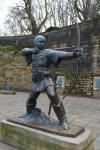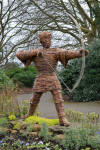Round The World and other travels
A frequent flyer's collection of trip diaries
March 2016: Nottingham
Nottingham is one of the three largest cities in the East Midlands, the other two being Leicester and Derby. Its city status dates from 1897, when it won its charter as part of the celebrations for Queen Victoria's Diamond Jubilee. It is inextricably linked with the Robin Hood legend, and in its day was famous for the production of lace. For those of us who lived through the 1980s, Nottingham will additionally be forever associated with ice dancers Jayne Torvill and Christopher Dean.
When Bruce first proposed the city as a possible weekend destination, I thought it was very much a left-field idea; however it turns out that Nottingham was placed 13th on the list of most visited English cities in 2014, a higher position than I would ever have imagined. Certainly we had an enjoyable time there, the oft repeated mantra during our stay being "Nottingham - who knew?"
Nottingham Castle
The present-day Nottingham Castle, standing proudly in a raised position on Castle Rock and set in extensive gardens, is the third-generation building of that name. The original 11th-century fortress was demolished 600 years later, to be replaced by a mansion that was itself razed in the 19th century. This was subsequently rebuilt as the museum and art gallery that we see today.
 |
 |
 |
 |
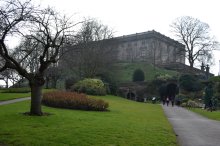 |
 |
 |
 |
 |
Old Market Square
Old Market Square is the focal point of Nottingham city centre, and indeed it had a lively market in progress during our stay. It is also home to the imposing sight of the 'Council House', Nottingham's city hall. It's a name that tends to cause a degree of amusement in UK citizens who are not from the Midlands.
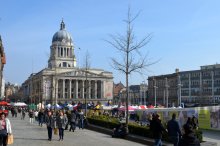 |
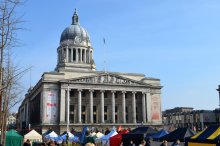 |
 |
LEFT: Nottingham's 'Council House', in Old Market Square |
 |
Lace Market quarter and St Mary's Church
The Lace Market is an attractive and interesting corner of Nottingham city centre. Now a protected heritage area, it is home to many fine examples of 19th-century industrial architecture, including renovated former warehouses. The historic Church of St Mary the Virgin dates from the 14th century and is the oldest religious building in the city. The church was mentioned in the Domesday Book and even turns up in the tales of Robin Hood, but nowadays it is better known for its strong choral tradition. Just along the street (High Pavement), we made an interesting Sunday-afternoon visit to the Galleries of Justice Museum.
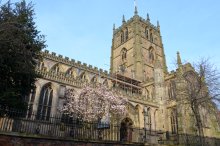 |
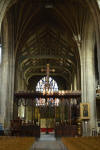 |
 |
 |
 |
 |
 |
 |
Other views
 |
 |
 |
 |
 |
 |
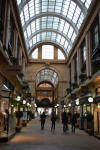 |
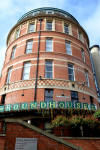 |
 |
 |
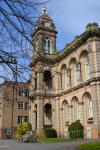 |
 |
 |
 |
 |
Robin Hood
Robin Hood and his Merry Men, usually portrayed as a band of outlaws who rob the rich to provide for the poor, are popular and enduring heroes of English folklore. The earliest tales describe Robin as living in Sherwood Forest, a real place in the northern part of Nottinghamshire. Robin's arch-enemy in the stories is the Sheriff of Nottingham.
Base: Mercure City Centre
Linked report from same trip:
